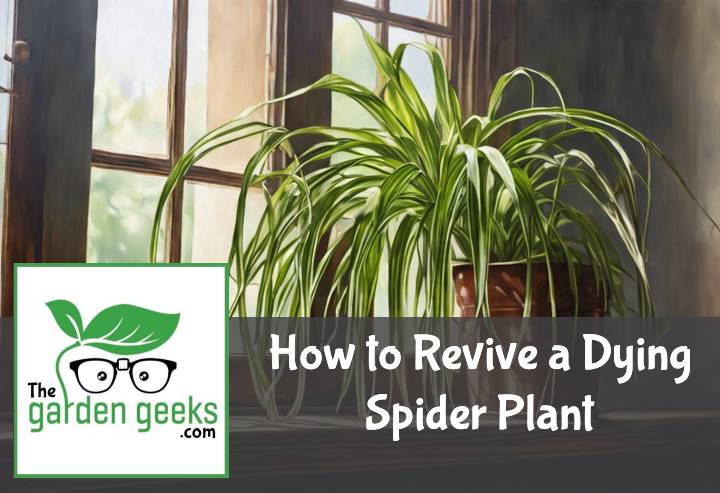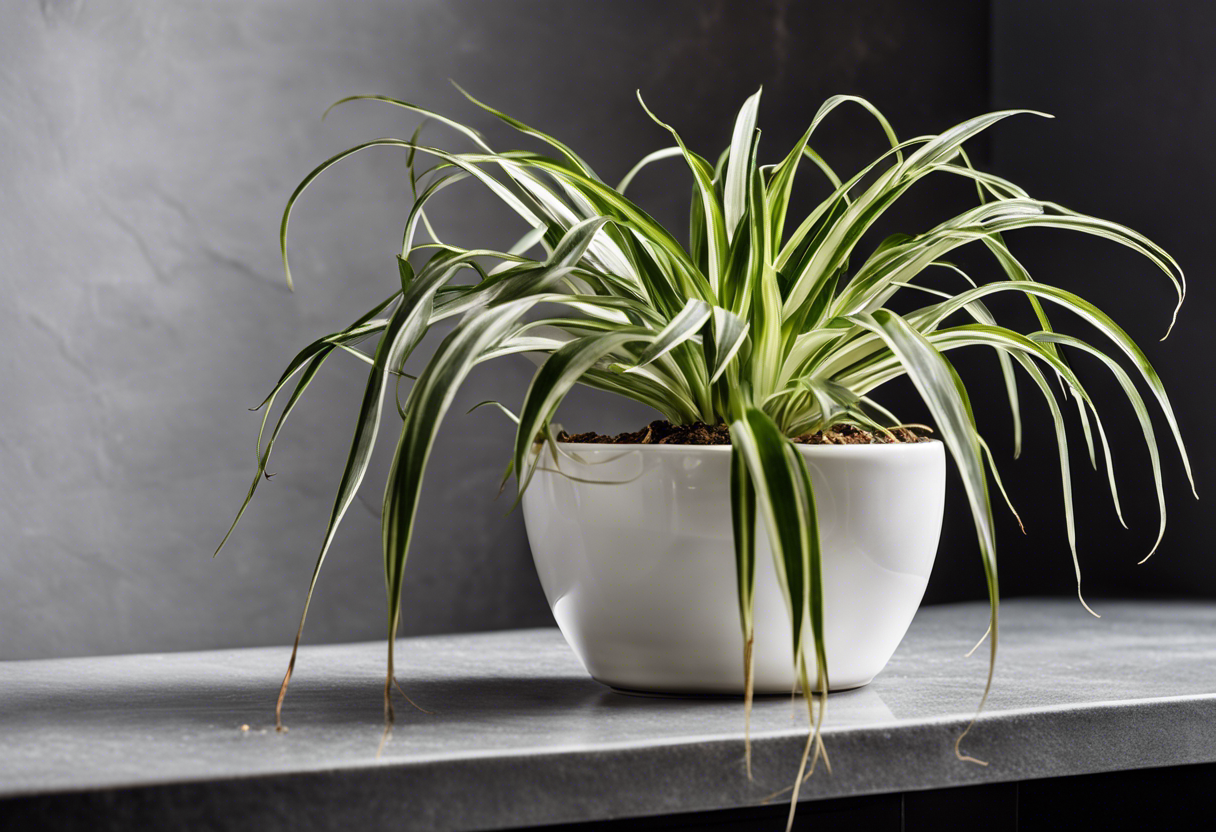Ever found yourself staring at your beloved Spider Plant, wondering why it’s looking so down in the dumps? Well, you’re not alone. I’ve been there too, and let me tell you, it’s a real heartbreaker. But fret not! With How to Revive a Dying Spider Plant, we’re going to turn that frown upside down.
In this guide, we’ll dive into the nitty-gritty of what makes Spider Plants tick (or not), and arm you with all the know-how to bring your green buddy back from the brink. So buckle up plant parents, because we’re about to embark on a life-saving mission! Keep reading about How to Revive a Dying Spider Plant.
Key Takeaways
- Identify signs of a dying spider plant, such as yellowing leaves and wilting.
- Overwatering is a common cause; ensure the plant is watered only when the top inch of soil is dry.
- Provide indirect sunlight; too much direct sunlight can harm the plant.
- Use well-draining soil to prevent root rot.
- Regularly prune dead or dying leaves to promote new growth.
- Fertilize every 2 weeks during growing season with a balanced houseplant fertilizer.
Understanding the Spider Plant
Let’s get to know our green friend, the spider plant. It’s not just about how to revive a dying spider plant, but also understanding its characteristics and why it’s important.
What is a Spider Plant?
A spider plant is a popular houseplant known for its easy care and unique look. Originating from tropical and southern Africa, this plant has made its way into homes worldwide. Its common features include long, slender leaves that arch outward like a fountain.
The leaves are typically variegated with a white or yellow stripe running down the center. The name “spider plant” comes from its “pups” or baby plants, which hang down from the mother plant like spiders on a web.
Recognizing a Healthy Spider Plant
So, how do you spot a healthy spider plant? Well, it’s all in the appearance and growth patterns. A healthy spider plant will have vibrant green leaves that stand erect and arch outwards.
The variegation on the leaves should be clear and bright, not faded or discolored. As for growth patterns, healthy spider plants are fast growers during warmer months and slow down during cooler periods.
Identifying Signs of a Dying Spider Plant
Now let’s talk about when things go south – identifying signs of a dying spider plant. If your spider plant starts showing changes in leaf color such as browning or yellowing, it might be in trouble.
Another sign could be decreased growth rate or drooping leaves that were once upright and perky. Remember folks, knowledge is power! So keep an eye out for these signs to ensure your green buddy stays happy and healthy.
Causes of a Dying Spider Plant
So, your spider plant is looking a bit under the weather, huh? Well, don’t fret! Spider plant problems can often be traced back to a few common causes. Let’s dive into these pesky issues that could be causing your plant’s demise.
Inadequate Watering
First off, let’s talk about water – or the lack thereof. Both overwatering and underwatering can lead to dying spider plant symptoms. Overwatering can cause root rot, while underwatering leaves your poor plant parched and wilting.
Now you might be thinking, “I’ll just give it more water then!” Hold up there, eager gardener! Overwatering spider plants is one of the most common spider plant care mistakes. Too much water can drown the roots and create an environment for mold and fungus.
On the flip side, underwatering isn’t any better. Your spider plant needs moisture to thrive. If it’s not getting enough, it’ll start showing signs of distress like drooping leaves and browning tips.
Poor Lighting Conditions
Next on our list of culprits is lighting. Spider plants are pretty forgiving when it comes to light conditions but they do have their limits. Too much or too little light can spell trouble for your green buddy.
If your plant isn’t getting enough light (effects of low light on plants), it may start losing its vibrant color and stop growing altogether. On the other hand, too much direct sunlight can scorch its leaves (too much light for spider plants) causing them to turn brown or yellow.
Incorrect Temperature
Temperature swings are another potential problem area when figuring out how to revive a dying spider plant. These plants aren’t fans of extreme temperatures or sudden changes in their environment.
Spider plants prefer moderate temperatures – not too hot and not too cold (ideal temperature for spider plants). If they’re exposed to cold drafts or intense heat, they can become stressed and start showing signs of damage.
Nutrient Deficiency
Last but not least, let’s talk nutrients. Just like us, plants need a balanced diet to stay healthy. A lack of essential nutrients can lead to poor growth and even death in spider plants.
If your plant isn’t getting the nutrients it needs (spider plant nutrient needs), it might start showing signs like yellowing leaves or slow growth. Remember, over-fertilizing can be just as harmful as under-fertilizing. It’s all about finding that sweet spot!
Diagnosing Your Spider Plant’s Problem
When it comes to how to revive a dying spider plant, the first step is always diagnosis. It’s like playing detective, but for your leafy friend. You need to understand what’s causing those spider plant problems before you can fix them.
Assessing Symptoms and Their Possible Causes
Now, let’s talk about symptoms. If your spider plant looks more like a Halloween prop than a houseplant, it might be showing signs of distress. Maybe the leaves are yellowing or there are brown tips everywhere. These are common spider plant symptoms that could indicate overwatering or poor soil quality.
On the other hand, if your plant has lost its vibrant green color and looks dull, it might be due to lack of sunlight. Remember, these plants love bright but indirect light! So, diagnosing indoor plant issues is all about observing and understanding these signs.
Common Diseases in Spider Plants
Moving on to diseases – yes, unfortunately, our green buddies can get sick too. One common disease is root rot which usually happens when the plant is overwatered and the roots start decaying – yikes!
Another one is leaf tip burn which could be due to high salt content in water or even over-fertilization. The leaves will have brown tips as if they’ve been burnt (hence the name).
So remember folks, proper spider plant care involves timely diagnosis and treatment of these diseases. After all, prevention is better than cure!
Reviving Techniques for Your Dying Spider Plant
Let’s dive into the nitty-gritty of How to Revive a Dying Spider Plant. We’ll cover everything from watering, light exposure, temperature regulation, and nutrient supplementation.
Adjusting Watering Practices
First off, let’s talk about water. Too much or too little can send your spider plant on a one-way trip to brown-town. Overwatering is a common mistake in spider plant care, leading to root rot and yellow leaves.
On the flip side, underwatering isn’t great either. It can cause wilting and dryness. So what’s the sweet spot? Aim for moist but not soggy soil. A good rule of thumb is to water when the top inch of soil feels dry.
Modifying Light Exposure
Next up: light exposure. Spider plants are like Goldilocks; they want their sunlight just right! Too much sun can scorch their leaves while too little can stunt growth.
The ideal light conditions for spider plants are bright but indirect light. If your plant is getting too much sun, consider moving it further away from the window or using sheer curtains to filter the light.
Regulating Temperature
Temperature matters too! Spider plants prefer temperatures between 65-75°F (18-24°C). They’re not fans of extreme heat or cold.
If you’re dealing with a chilly environment, try moving your plant away from drafty windows or doors. For hot spots, consider using a small fan to circulate air around your indoor garden.
Supplementing with Necessary Nutrients
Lastly, don’t forget about nutrients! Just like us humans need our vitamins, spider plants need certain nutrients to thrive.
Key nutrients include nitrogen for leaf growth and phosphorus for root development. If you notice yellow leaves or slow growth, it might be time for some nutrient supplementation in your indoor plant revival techniques. A balanced houseplant fertilizer should do the trick!
Preventive Measures to Keep Your Spider Plant Healthy
When it comes to maintaining plant health, especially our beloved spider plants, prevention is indeed better than cure. So, let’s dive into the preventive measures for plants that can keep your green buddy thriving.
Regular Monitoring and Care Routine
First things first, a consistent spider plant care routine is key. Like a baby, your plant needs regular check-ups too. Look out for any signs of distress or disease.
Yellowing leaves? Could be overwatering. Brown tips? Might be low humidity. Regular monitoring helps you catch these issues early and nip them in the bud.
Proper Feeding and Watering Schedule
Next up, let’s talk about feeding and watering. Establishing an optimal spider plant feeding schedule is crucial for its health.
Remember, overwatering is a common mistake that can lead to root rot. On the other hand, underwatering can leave your plant thirsty and stressed out. So finding that sweet spot in watering spider plants properly is essential.
Ensuring Adequate Light and Temperature Conditions
Last but not least, providing appropriate light and temperature conditions plays a significant role in keeping your spider plant happy and healthy.
Spider plants are pretty flexible when it comes to light – they can tolerate low light but thrive best in bright indirect sunlight. As for temperature, they prefer cooler conditions – ideally between 55-65°F (13-18°C).
So there you have it! By following these preventive measures, you’ll know exactly how to revive a dying spider plant before it even gets to that stage!
To Wrap Up
So, we’ve journeyed through the jungle of How to Revive a Dying Spider Plant. It’s not rocket science, but more like baking a cake – get the ingredients right and you’re golden.
Remember, your spider plant isn’t asking for a trip to Mars; it just needs some TLC. So go on, put on that green thumb and bring back the life in your leafy companion!





